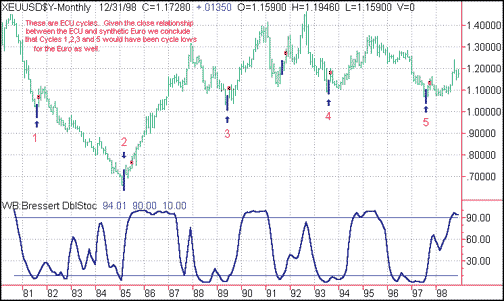MARKET TIMING
The Euro's True Colors
by Walter Bressert and Doug Schaff
How do you analyze the Euro, a currency that sprang to life with no price history?

FIGURE 1: THE ECU. Figure 1 is a monthly chart of the Ecu going back 20 years. Ecu four-year cycle bottoms are shown in 1981 (1), 1985 (2), 1989 (3), August 1993 (4), and August 1997 (5). The blue indicator drawn under the price bars is the Bressert double stochastic, which does a good job of finding the four-year cycle bottoms. To target the four-year Ecu cycles, use a cycle length of 20 as the input for the stochastic. You can see it hits bottom at all the four-year lows. A buy signal confirming each four-year low is constructed using the Bressert double-stochastic buy signal. When the oscillator turns up from below a buy line of 10, the price bar above it is painted blue.There is no doubt that fundamental factors will determine the Euro's value, as they have for the German mark, the French franc, and other currencies. The problem arises in interpreting the direction and impact of gross domestic product (GDP), trade, interest rates, and politics in the short run. In addition, while fundamentals move the markets, they often look the most bullish at tops and the most bearish at bottoms. On July 9, 1998, the mark, the franc, and other European currencies made cycle lows. The currencies rallied in October of that year on the back of weaker US capital markets and positive anticipation for the Euro -- talk of economic synergies, a smooth start for the new currency, and capital flowing into Europe.
Now that the Euro has been established, the currencies are below the levels of October 1998, and reality has set in again. Market participants are beginning to wonder how this new currency is going to overcome the high taxes, expensive social policies, and bureaucratic structure thatís kept Europe from creating any net new jobs in the past decade.
Why the change in outlook? Have the Euro's fundamentals changed? No -- but their interpretation or emphasis has. Cycle research can be of special assistance in this new environment to help balance economic and political analysis as a clearer fundamental picture emerges for this new currency.
If we could determine the Euro's long-term cycles and the position of the Euro within the current cycle, we could forecast price direction for the coming months and years, and even anticipate the next trend reversal. But this is not simply a case of analyzing cycles. What would we do for data? What could we say with confidence about this new currency? No matter how statistically impressive the data used to estimate the Euro's cycles is, we cannot forget the Euro has only traded since the beginning of 1999 -- barely a few months.
Since no actual Euro price data exists prior to that date, we had to search for data that could approximate where the Euro would have traded if it had been in existence during the past 20 years and extrapolate from that point. There is extensive data on currencies such as the European currency unit (ECU) and the German mark, which can to some extent function as proxies for the Euro. Synthetically created histories of the Euro are based on currency histories of the countries participating in the new legal tender (referred to hereafter as "Euro currencies"). Neither solution to the data problem is perfect, but together, they can provide a firm basis on which to estimate the long-term cycles for the Euro and forecast future price movement.
A MIXED FUNDAMENTAL PICTURE
The Euro's economic potential is impressive, but its success against other currencies in a fragile global economy is not assured. It is now the official currency for 11 European Union (EU) member states -- Austria, Belgium, Finland, France, Germany, Italy, Ireland, Luxembourg, the Netherlands, Spain, and Portugal. The currencies of those nations will continue to circulate as legal tender until 2002, when they will be withdrawn permanently. The Euro's economic zone rivals that of the United States. The population of the Euro's economic zone, at nearly 300 million, is slightly larger than that of the US. The Euro area makes up 20% of total world trade and global GDP.
With the Euro and without exchange rate risks, European business costs will be lower, boosting stock performance and attracting capital. The EU's foreign exchange reserves are $350 billion compared with about $50 billion for the US. The individual countries used to need enough reserves to separately defend their currencies; the group can now stabilize its single currency with much less capital. The result is that, for practical purposes, the EU is sitting on $200 billion to $300 billion worth of excess reserves. Most of these are in dollars and will be sold in coming years, putting a floor on the price of the Euro.